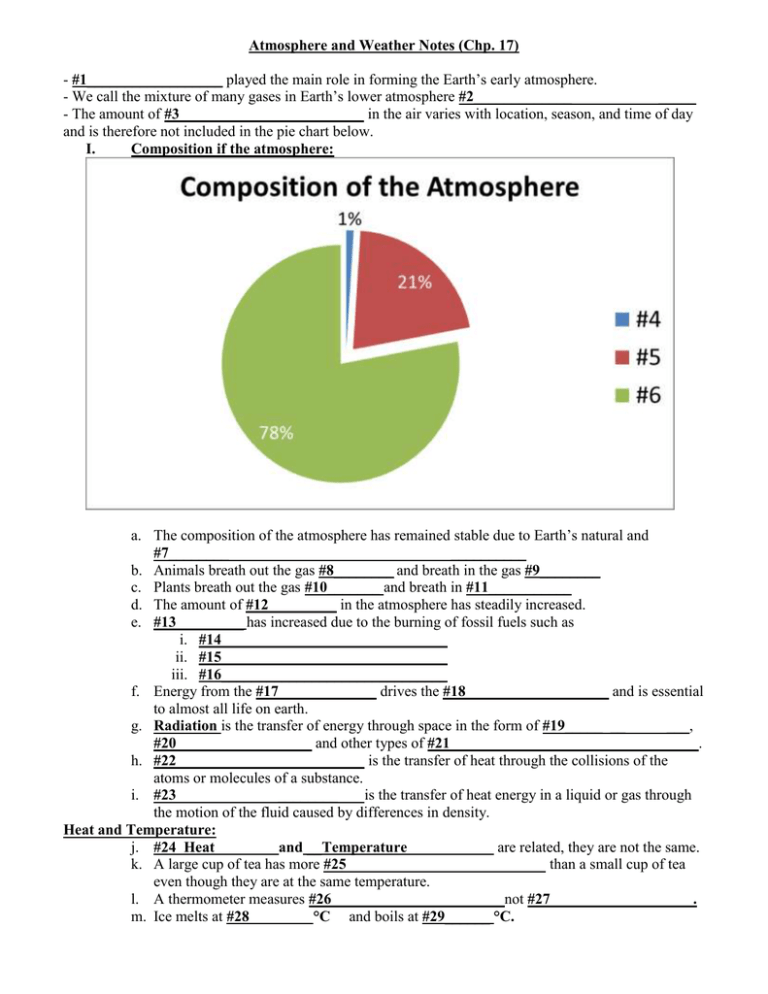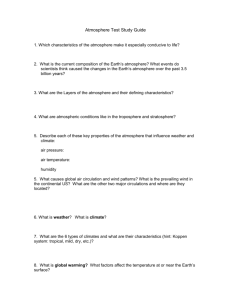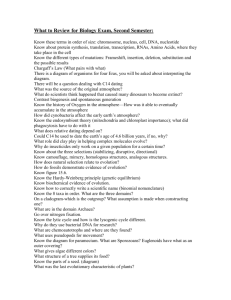Atmosphere and Weather Notes (Chp. 17) #1__________________
advertisement

Atmosphere and Weather Notes (Chp. 17) - #1__________________ played the main role in forming the Earth’s early atmosphere. - We call the mixture of many gases in Earth’s lower atmosphere #2_____________ _____ - The amount of #3______ ___ in the air varies with location, season, and time of day and is therefore not included in the pie chart below. I. Composition if the atmosphere: a. The composition of the atmosphere has remained stable due to Earth’s natural and #7________ __________ b. Animals breath out the gas #8________ and breath in the gas #9________ c. Plants breath out the gas #10_______ and breath in #11___________ d. The amount of #12_________ in the atmosphere has steadily increased. e. #13_________ has increased due to the burning of fossil fuels such as i. #14______________________________ ii. #15______________________________ iii. #16______________________________ f. Energy from the #17_____________ drives the #18___________________ and is essential to almost all life on earth. g. Radiation is the transfer of energy through space in the form of #19_____ __ ___, #20___________ ____ and other types of #21___________________ ____________. h. #22_________________________ is the transfer of heat through the collisions of the atoms or molecules of a substance. i. #23 ________ is the transfer of heat energy in a liquid or gas through the motion of the fluid caused by differences in density. Heat and Temperature: j. #24 Heat and __Temperature are related, they are not the same. k. A large cup of tea has more #25 than a small cup of tea even though they are at the same temperature. l. A thermometer measures #26 not #27 . m. Ice melts at #28 °C and boils at #29______ °C. II. Layers of the atmosphere: #39_____ #30_____________ _ Decreasing Air Pressure #35__________ #31____________ Altitude (km) #40_____ #32____________ #41_____ (moves within this layer“aurora borealis” -highly ionized) #36________ #37________ #33____________ #38________ #42_____ #34____________ -100 a. b. c. d. e. f. g. -80 -60 -40 -20 0 20 Temperature (C) #43_______________________________________-closest to earth i. Nearly 80% of the total mass of the atmosphere ii. most weather occurs in this layer iii. most pollutants stay here #44______________________________________________ i. solar energy absorbed by ozone layer 1. Ozone = O3 absorbs harmful UV rays 2. Without it skin cancer would be high 3. destroyed by chlorofluorocarbons and aircraft fuel ii. #45_________________________________________ gases remain here #46_______________________________________________ i. meteors burn up here #47_______________________________________________ i. highly #48__________________________________ from UV rays from the sun knocking electrons off oxygen and Nitrogen ii. can disrupt #49_____________________________________. iii. northern lights-Aurora Borealis Thermosphere i. Temp. increases to above 1000C Exosphere-outermost layer i. most satellites are here, basically like space The pauses-transitions between layers and temperature remains same i. #50_______________________________________(closest to earth) ii. #51_______________________________________ iii. #52_______________________________________(furthest from earth)






